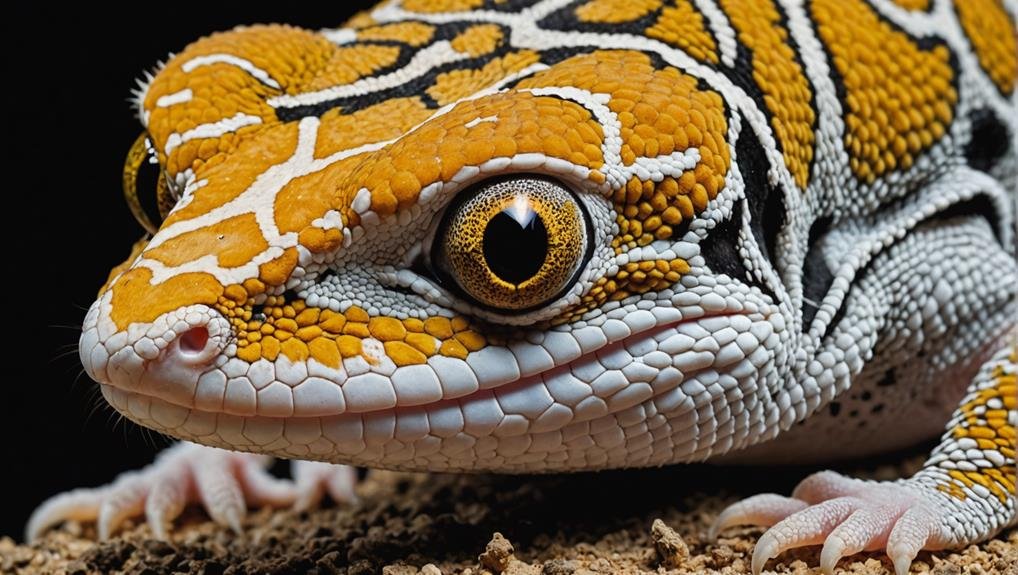When caring for a leopard gecko, you might notice that despite your best efforts, they can still face common health issues. Chronic malnutrition, for instance, often stems from a lack of essential nutrients, leading to serious conditions like calcium deficiencies and hepatic lipidosis. You should also be aware of hypovitaminosis A, which results from a vitamin A deficiency and can cause various health problems. Additionally, an imbalanced diet can lead to Nutritional Secondary Hyperparathyroidism. But these are just the beginning. Have you considered how low humidity levels might affect your gecko’s skin or the impact of digestive issues like intestinal impactions?
Key Takeaways
- Calcium Deficiency: This is often due to a poor diet and leads to metabolic bone disease; ensure calcium-rich insects and proper supplementation.
- Inappropriate substrates can cause intestinal impacts. Symptoms include lethargy and loss of appetite, which require prompt veterinary care.
- Phalangeal Dysecdysis: Low humidity leads to retained shed on toes; provide a moist hide and maintain proper moisture.
- Hypovitaminosis A: Results from inadequate dietary choices; gut-load feeder insects with vitamins and manage nutrition proactively.
- Egg Retention: Females may experience egg binding; look for symptoms and seek veterinary intervention if necessary.
Chronic Malnutrition
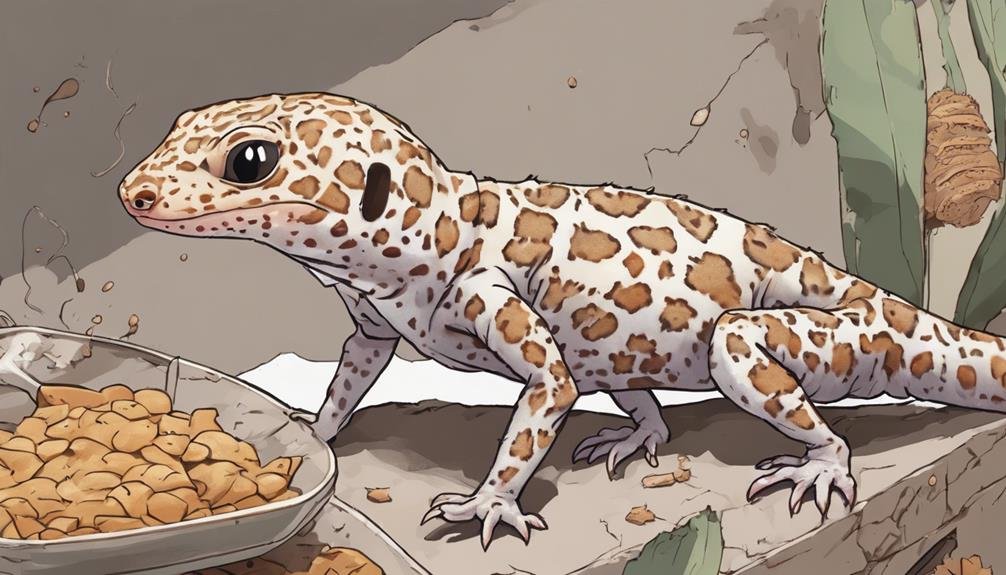

Chronic malnutrition is a vital health issue in leopard geckos, often stemming from diets that don’t provide essential nutrients. A common culprit is calcium deficiency, which can lead to serious health problems. To prevent chronic malnutrition, you need to offer a variety of calcium-rich insects, such as crickets and mealworms. Your gecko’s bones can weaken without sufficient calcium, leading to fractures and other skeletal issues.
If your leopard gecko suffers from chronic malnutrition, it might develop hepatic lipidosis, a dangerous condition where fat accumulates in the liver. This typically occurs when the body breaks down fat reserves due to inadequate nutrition. Treating chronic malnutrition often involves long-term stomach tubing to guarantee your gecko receives the necessary nutrients. This intensive care is essential for their recovery.
Recovery from chronic malnutrition usually takes about 6 to 8 weeks with proper care and nutrition. Monitor your gecko closely during this period and maintain a consistent feeding schedule. Ensure their diet includes a balanced mix of calcium-rich insects and other essential nutrients. Addressing chronic malnutrition promptly can improve your leopard gecko’s health and longevity.
Hypovitaminosis A
Hypovitaminosis A is a prevalent issue in leopard geckos due to poor dietary choices. When geckos eat a diet lacking essential vitamins, particularly vitamin A, they can develop several health problems. These issues include retained hemipenal casts, where the reproductive organs fail to shed properly, impaired shedding, and significant eye problems.
It’s vital to focus on proper dietary supplementation to prevent and treat hypovitaminosis A. Ensuring that your gecko’s diet includes a variety of nutrient-rich foods can make a significant difference. For instance, gut-loading feeder insects with high-vitamin A foods before feeding them to your gecko can greatly help.
Treatment often involves correcting the underlying dietary deficiencies when addressing hypovitaminosis A. This might mean adjusting what your geckos eat to include more vitamin A-rich options. Additionally, providing appropriate vitamin supplements can be an effective strategy.
Regularly monitoring your gecko’s health and making necessary dietary adjustments can help prevent hypovitaminosis A. By being proactive about your gecko’s nutrition, you can avoid the complications associated with this common health issue and ensure your pet remains healthy and happy.
Nutritional Secondary Hyperparathyroidism
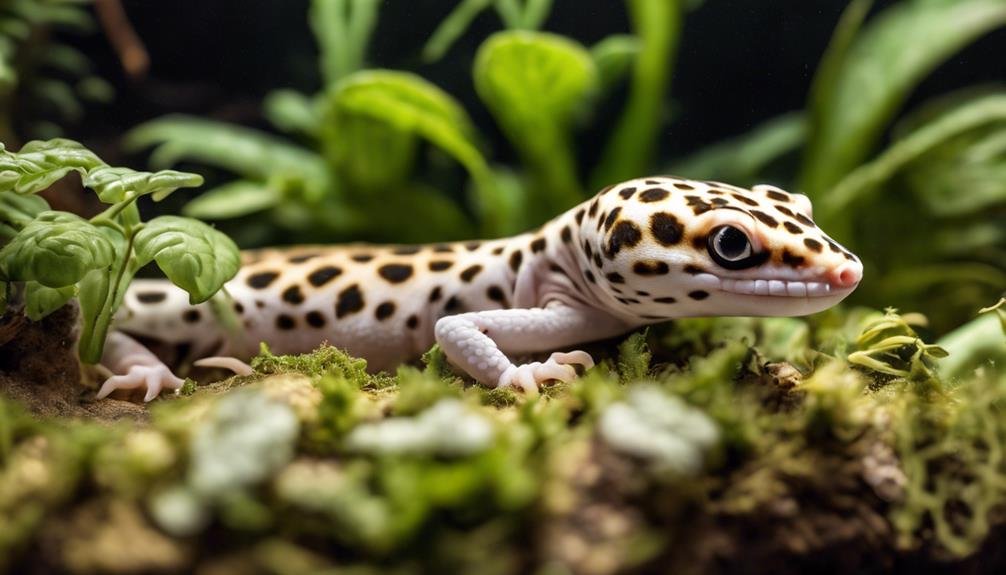

Nutritional secondary hyperparathyroidism (NSHP) is a significant health issue in leopard geckos, which are often fed diets primarily crickets and mealworms. When your gecko doesn’t receive sufficient calcium and vitamin D, it can develop Metabolic Bone Disease (MBD), characterized by weak bones and other skeletal deformities.
You might notice clinical signs of NSHP, such as stuck sheds, anorexia, and lethargy. These symptoms can manifest as misshapen limbs and a soft mandible, indicating severe calcium deficiency. These conditions can worsen without intervention, so it is important to address them promptly.
Treatment for NSHP can take several months and requires your commitment. You’ll need to ensure that your gecko receives a balanced diet with proper supplementation of calcium and vitamin D. Additionally, providing UVB light can help your gecko synthesize vitamin D, promoting better calcium absorption and bone health.
Successful treatment hinges on your willingness to provide the necessary care and adjustments in your gecko’s environment and diet. These steps can help your leopard gecko recover from NSHP and prevent Metabolic Bone Disease from progressing. Regular veterinary check-ups will also aid in monitoring your gecko’s recovery.
Phalangeal Dysecdysis
Phalangeal Dysecdysis, caused by low humidity levels, can lead to retained sheds on your leopard gecko’s toes and tail, restricting blood circulation. To prevent this, provide a moist hide or nest box to aid in shedding. If your gecko has retained sheds, carefully remove them after soaking, but severe cases might need veterinary intervention.
Low Humidity Causes
When humidity levels drop too low in a leopard gecko’s enclosure, it can lead to a serious condition known as phalangeal. This condition occurs due to low humidity, causing retained sheds on the toes and tail. Retained sheds restrict blood circulation and can cause serious health issues if not addressed promptly.
To prevent phalangeal dysecdysis, you must maintain proper humidity levels in your gecko’s habitat. Here are a few effective strategies:
- Moist hide: Provide a moist hide or nest box to create a humid microenvironment that aids in shedding.
- Regular misting: Mist the enclosure regularly to keep humidity levels within the best range.
- Substrate choice: Use a substrate that retains moisture well, such as coconut fiber or sphagnum moss.
If you notice signs of phalangeal dysecdysis, like retained sheds, take immediate action by improving the humidity levels and ensuring your gecko has access to a moist hide. Early intervention is essential to avoid severe complications. Low humidity is a common cause, but it’s entirely preventable with the right care and attention.
Removing Retained Sheds
Retained sheds in leopard geckos, or phalangeal dysecdysis, require prompt and careful intervention to prevent serious health issues. When your gecko fails to shed properly, especially on the toes and tail, it can restrict blood circulation, leading to severe complications. Low humidity levels often cause phalangeal dysecdysis, so addressing the underlying environment is important.
First, carefully inspect your gecko for signs of retained sheds. If you notice any, soaking your gecko in lukewarm water for 15-20 minutes can help loosen the dead skin. After washing, gently remove the retained sheds using tweezers or a cotton swab.
Here’s a quick reference table for the steps:
| Step | Description |
|---|---|
| 1. Inspect | Check toes and tail for retained sheds. |
| 2. Soak | Soak in lukewarm water for 15-20 minutes. |
| 3. Remove | Gently eliminate sheds with tweezers/swab. |
| 4. Observe | Monitor for any signs of infection. |
| 5. Consult | Seek vet help if sheds persist or worsens. |
In severe cases where retained sheds cause significant damage, amputation under anesthesia might be necessary. Always consult a veterinarian if you’re unsure or if the condition worsens.
Prevention Through Environment
Maintaining the correct environment is crucial for preventing phalangeal dysecdysis in leopard geckos. Due to low humidity levels, this gecko species often suffers from retained sheds on their toes and tails. These retained sheds can restrict blood circulation, eventually leading to severe complications. To prevent this, focus on creating an ideal habitat for your pet.
- Humidity Control: Make sure your gecko’s enclosure has adequate humidity levels. A damp hide or nest box provides a moist microclimate where your gecko can retreat to help shed. Regular misting can also assist in maintaining the necessary moisture.
- Regular Monitoring: Regularly check your gecko for signs of retained shed, especially around the toes and tail. Early intervention is crucial to preventing more serious issues like restricted blood flow, which, if left untreated, might lead to amputation under anesthesia.
- Diet and Hydration: A poor diet can worsen shedding problems. Guarantee your gecko’s diet is balanced with essential nutrients and proper hydration. A healthy gecko is better equipped to shed properly and avoid complications.
Intestinal Impactions
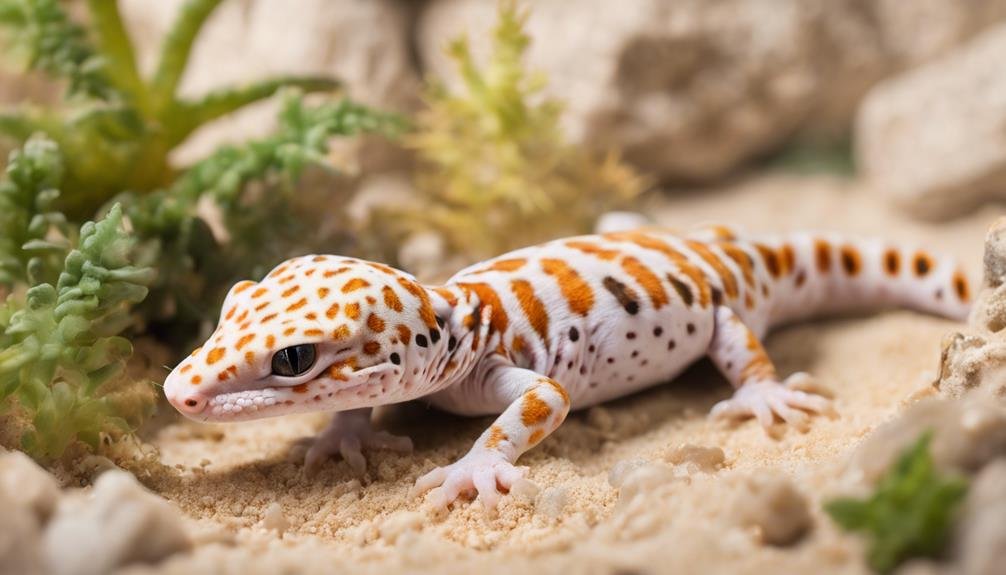

Leopard geckos, often beloved for their low-maintenance care, can nevertheless face serious health issues like intestinal impactions. These impactions are common and typically result from ingesting inappropriate substrates used in their habitat used in their habitat, such as sand or crushed walnut shells. When your gecko swallows these materials, they can accumulate in the digestive tract, leading to blockages.
You’ll need to watch for clinical signs of impactions, which include lethargy, straining to defecate, and, in severe cases, cloacal or colonic prolapse. If left untreated, these symptoms can lead to significant discomfort and health complications for your pet.
To prevent intestinal impactions, avoiding using calcium-enriched sands and other substrates that can pose risks to your gecko’s digestive system is essential. Instead, opt for safer alternatives like reptile carpets or paper towels.
If your leopard gecko shows symptoms of impaction, seek veterinary care promptly. Treatment may involve dietary changes and providing a suitable environment for recovery. Regularly monitoring your gecko’s health and habitat is vital to catch any early signs of trouble, ensuring prompt intervention and a healthier life for your pet.
Abscesses
When your leopard gecko develops an abscess, it is important to identify and diagnose it early for effective treatment. Treatment typically involves lancing, debridement, antibiotics, pain medications, and proper nutritional support. Regular monitoring and timely intervention are essential to prevent complications and guarantee your gecko’s recovery.
Identification and Diagnosis
Abscesses in leopard geckos are subcutaneous infections that can pose serious health risks if not promptly identified and treated. Recognizing these abscesses early is vital to prevent complications like systemic infections or worsening of the condition. Unlike bone diseases, abscesses are often localized swellings filled with pus that can be painful for your gecko.
To identify an abscess, look for the following signs:
- Swelling: Noticeable lumps under the skin, often firm to the touch.
- Redness or Discoloration: Affected areas may appear red or darker than the surrounding skin.
- Behavioral Changes: Your gecko might show discomfort, reduced appetite, or lethargy.
Proper diagnosis involves a veterinarian conducting a culture with sensitivities. This helps determine the most effective antibiotic treatment for the specific bacteria causing the infection. Nutritional support is essential during treatment to aid your gecko’s healing and recovery.
Regular monitoring for signs of abscess formation is crucial. Monitor your gecko’s skin and overall behavior to catch any issues early. Taking these steps ensures you can address abscesses promptly, maintaining your gecko’s health and well-being.
Treatment and Management
Treating abscesses in leopard geckos involves a few key steps to guarantee a complete recovery. First, a qualified veterinarian will lance and debride the abscess, removing the infected material and cleaning the wound.
Once the abscess is open, your vet will likely take a culture to identify the bacteria causing the infection. This is important for determining the most effective antibiotics to use.
After the initial procedure, you’ll have to administer antibiotics as prescribed. These medications are necessary to combat the infection and prevent it from spreading. Pain management is also crucial; your vet may provide pain medications to keep your gecko comfortable during healing.
Nutritional support plays a significant role in your gecko’s recovery. Ensure they eat well and get the nutrients to boost their immune system. Offering a balanced diet can make a notable difference in their healing.
Prompt and proper treatment of abscesses is vital to prevent further complications. Regular follow-ups with your vet will help monitor the healing process and make any necessary adjustments to the treatment plan. This thorough approach guarantees your leopard gecko returns to full health.
Diarrhea
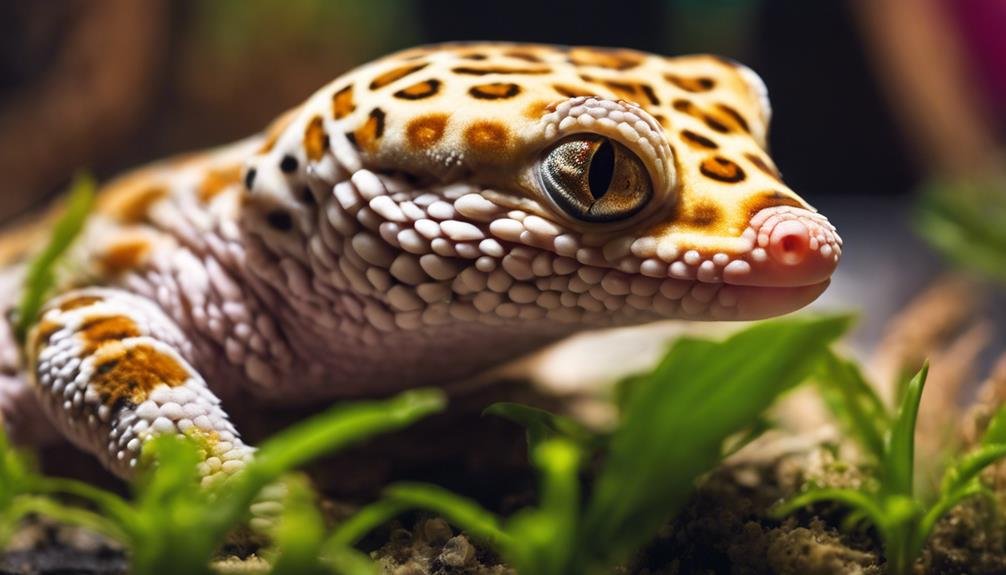

Diarrhea in leopard geckos is a concerning health issue marked by abnormal stools containing undigested insects. You might notice your gecko has a good appetite but is still experiencing weight loss. This is a clear indication something’s wrong. If diarrhea is left untreated, it can progress to a lack of appetite, severely impacting your gecko’s overall health.
When you see watery or smeared stools, it’s a sign of an underlying issue that needs prompt treatment. Immediate action is vital to prevent serious complications. Here’s what you should look out for:
- Weight Loss: Even if your gecko is eating well, diarrhea can cause them to lose weight rapidly.
- Abnormal Stools: Stools that are watery, smeared, or contain undigested insects are a red flag.
- Appetite Changes: Initially, your gecko might eat normally, but untreated diarrhea can lead to a complete lack of appetite.
Ocular Problems
Regarding ocular problems in leopard geckos, debris under the eyelids can cause ulcers and significant discomfort. You should watch for symptoms like frequent eye rubbing or squinting and guarantee a balanced diet to prevent issues like hypovitaminosis A. Treatment usually involves removing debris, flushing the eyes, and administering antibiotics, so prompt action is essential for your gecko’s eye health.
Causes of Eye Issues
Eye issues in leopard geckos often originate from small particles of debris trapped under their eyelids, leading to painful ulcers. When debris remains under the eyelid, it can cause irritation and infection if not promptly addressed. They ensure that your leopard gecko’s clean environment can greatly reduce the risk of debris-related eye problems.
Another major cause of ocular issues in geckos is hypovitaminosis A, a condition caused by a vitamin A deficiency. This nutritional deficiency can lead to various health problems, including eye issues. Ensuring a balanced diet with sufficient vitamin A is vital for your gecko’s eye health.
Treatment for eye issues generally involves:
- Careful removal of solid debris: This often requires the assistance of a veterinarian to avoid further injury.
- Flushing the eyes: This helps to remove any remaining particles and reduce irritation.
- Administration of antibiotics: Both systemic and ocular antibiotics are necessary to combat infection and promote healing.
Maintaining eye health is essential for the overall well-being of your leopard gecko. Regular check-ups and a proper diet can help prevent many of these issues, ensuring your pet stays healthy and comfortable.
Symptoms to Watch
Recognizing the symptoms of ocular problems in leopard geckos is vital for timely intervention and treatment. One of the primary indicators is the presence of ulcers, often caused by debris getting stuck under the eyelids. If your gecko frequently rubs its eyes or keeps them closed, these could be signs of discomfort or irritation. Hypovitaminosis A, a condition linked to poor nutrition, can lead to eye issues, underlining the importance of a balanced diet rich in essential nutrients.
Another symptom to watch for is swelling around the eyes. This can signal an infection or inflammation that needs immediate attention. Cloudiness or changes in eye color might also indicate underlying problems. A gecko’s eyes should be clear and bright; dullness or opacity is a red flag.
Also, be alert for signs of bone loss, which can indirectly affect ocular health. Weak bones might lead to overall weakness, reducing your gecko’s ability to clean its eyes properly.
Maintaining good eye health is pivotal for your leopard’s and gecko’s well-being. Catching these symptoms early can significantly improve your pet’s diagnosis and quality of life.
Treatment and Prevention
Promptly addressing ocular issues in leopard geckos can significantly enhance their health and comfort. These issues often stem from debris under the eyelids, resulting in painful ulcers. To remedy this, you must carefully remove solid debris and flush the eyes with a saline solution. Follow this with systemic and ocular antibiotics to prevent infections and promote healing.
Hypovitaminosis, a common cause of ocular problems in leopard geckos, underscores the significance of proper nutrition. Ensure your gecko’s diet includes a balanced mix of vitamins to support overall eye health. Eye health is vital for their well-being, as poor vision can lead to lethargy due to discomfort and stress.
To prevent ocular issues and guarantee your leopard gecko remains healthy, follow these steps:
- Regular Monitoring: Check their eyes frequently for signs of debris or ulcers.
- Proper Nutrition: Provide a balanced diet rich in essential vitamins, particularly vitamin A.
- Prompt Treatment: Address any eye problems immediately using appropriate treatments.
Stomatitis
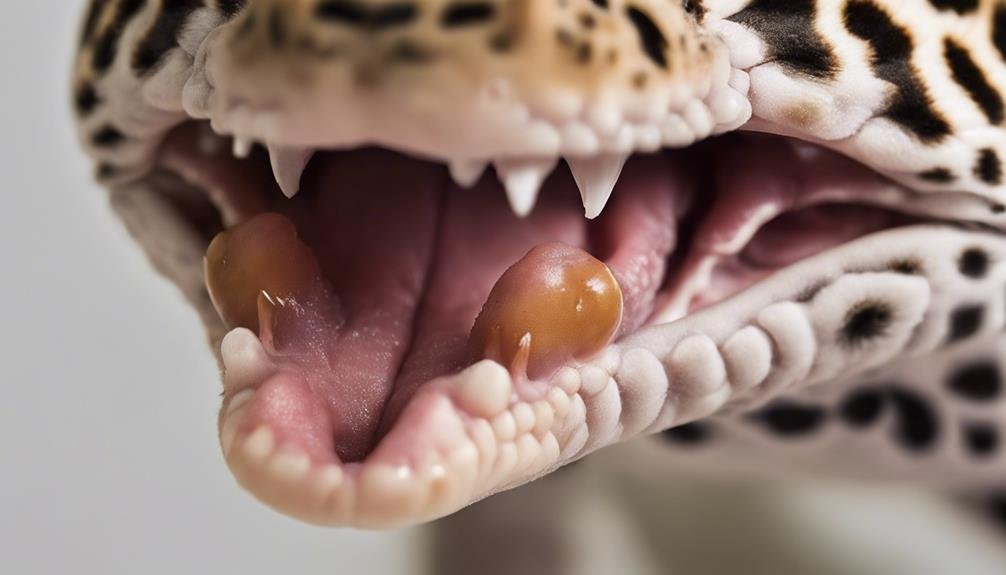

Although rare in leopard geckos, stomatitis significantly impacts their oral health and can lead to severe complications if left untreated. This condition, often linked to hypovitaminosis A, highlights the significance of proper nutrition for your gecko.
When a leopard gecko suffers from stomatitis, you’ll notice symptoms like swelling, redness, and pus in the mouth, making eating painful and challenging.
Proper diagnosis is essential for effective treatment. If you suspect stomatitis, consult a reptile veterinarian immediately. They’ll likely conduct a thorough examination and recommend lab tests to confirm the diagnosis. Once diagnosed, treatment typically involves cleaning the affected area and administering antibiotics. In severe cases, surgical intervention may be necessary.
Preventing stomatitis largely revolves around maintaining your gecko’s oral health. Ensure they receive a balanced diet rich in essential vitamins, particularly vitamin A. Regularly inspect their mouth for any signs of infection and keep their habitat clean to reduce the risk of bacterial contamination.
Egg Retention
Maintaining your leopard gecko’s health involves examining various potential issues, including egg retention. Leopard geckos typically lay two eggs, but sometimes they may retain one or both. This condition requires immediate attention. If you suspect egg retention, monitoring your gecko’s behavior is pivotal. Look for signs like prolonged restlessness or straining without producing eggs.
Here’s what you need to do:
- Radiographs: A single retained egg warrants radiographs to assess the situation. Your vet will use X-rays to determine the egg’s position and size.
- Consult a Vet: If the radiographs confirm egg retention, your vet might recommend a celiotomy. This surgical procedure involves making an incision to remove the egg, which can be life-saving.
- Monitor Behavior: Monitor your gecko’s egg-laying behavior closely to detect and prevent complications. Regular monitoring helps catch issues early.
Egg retention can lead to severe complications if not promptly addressed. By observing your leopard gecko closely and seeking veterinary advice when needed, you can help guarantee your pet’s well-being. Always consult a vet if you have concerns about your gecko’s health.
Conclusion
Taking care of your leopard gecko means staying vigilant about their health. Guarantee they receive a balanced diet rich in essential nutrients to avoid chronic malnutrition, hypovitaminosis A, and nutritional secondary hyperparathyroidism. Maintain proper humidity levels to prevent skin issues like phalangeal dysecdysis. Keep an eye out for digestive problems such as intestinal impactions and diarrhea. Regularly check for ocular issues and stomatitis and monitor females for egg retention. Your proactive care secures your gecko’s well-being and happiness.
FAQs
1. Do Leopard Geckos Have Health Problems?
Yes, leopard geckos can have health problems. Preventive care, such as proper diet and habitat setup, is essential. If you notice any signs of illness, consult a vet promptly to explore treatment options and maintain your well-being.
2. What Is a Common Disease in Leopard Geckos?
Metabolic bone disease is a common disease in leopard geckos. It would be best to focus on the metabolic bone disease by providing proper calcium and UVB lighting. Preventing impaction involves ensuring a safe substrate and appropriate diet.
3. How Do I Know if My Leopard Gecko Is Unhealthy?
You’ll know your leopard gecko’s unhealthy if you notice weight loss, lethargy, skin issues, or appetite loss. Check for retained shed, stuck eye caps, or abnormal bumps. Seek veterinary attention if signs or behaviors are concerning.
4. What Is Bad for Leopard Geckos?
Loose substrates and improper temperatures are environmental hazards for leopard geckos. Diet concerns include a lack of balanced nutrition and insufficient calcium. To prevent stress and aggression, avoid housing multiple geckos together.

